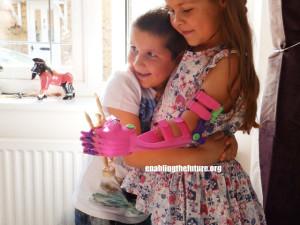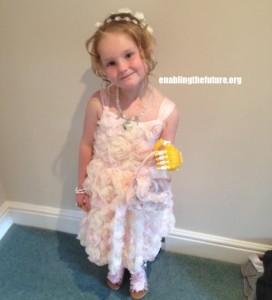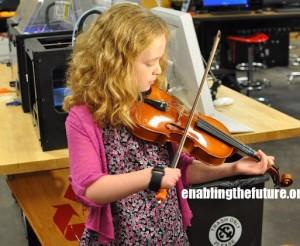e-NABLE Looks Back on a Successful Two Years of 3D Printed Prosthetics, Introduces Several New Designs
 Since its beginnings in 2013, e-NABLE has grown from a small community of about 100 makers into a giant network of around 7,000. Roughly 2,000 prosthetic devices have been created, benefiting people in approximately 45 countries. As the organization wraps up another year, e-NABLE volunteer and blogger Jen Owen spoke with leading designer Peter Binkley about some of the most successful designs of the past two years. Binkley has been a prolific designer, working on such designs as the Raptor Hand and the Ody Hand, and he reflected on how the community’s work has evolved throughout 2014 and 2015.
Since its beginnings in 2013, e-NABLE has grown from a small community of about 100 makers into a giant network of around 7,000. Roughly 2,000 prosthetic devices have been created, benefiting people in approximately 45 countries. As the organization wraps up another year, e-NABLE volunteer and blogger Jen Owen spoke with leading designer Peter Binkley about some of the most successful designs of the past two years. Binkley has been a prolific designer, working on such designs as the Raptor Hand and the Ody Hand, and he reflected on how the community’s work has evolved throughout 2014 and 2015.
“In 2014, designers really refined wrist powered designs but there grew an awareness that 3D printed assistive devices could and should be used for those with transradial and transhumeral upper limb differences,” Binkley said. “The RIT arm championed by Jon Schull and the RIT lab was a bold step into elbow-powered devices. In 2015, we saw some very nice improvements in wrist-powered devices, like the Phoenix hand, but also a lot of exploration into transradial devices, like the Flexy Arm, the Unlimbited Arm and some impressive improvements to the RIT arm design. We are also seeing some very exciting developments in low-cost myoelectric devices.”
As 2015 ends, e-NABLE has added several new designs to its website. The Osprey Hand, designed by Binkley, is a wrist-powered device based on several components of the Raptor Hand, but with alterations that include thicker cables and a universal-fit bracer. It’s also the first prosthetic hand designed specifically to use a Bowden push-pull mechanism.
 In May of this year, Jason Bryant’s Orthotic Rubber Band Hand, which combined elements from the Raptor Reloaded and Falcon V1 designs, was a work in progress. While it’s still an experimental design in progress, it has been rebranded the Phoenix Hand and has gathered a large group of community members working diligently to perfect it.
In May of this year, Jason Bryant’s Orthotic Rubber Band Hand, which combined elements from the Raptor Reloaded and Falcon V1 designs, was a work in progress. While it’s still an experimental design in progress, it has been rebranded the Phoenix Hand and has gathered a large group of community members working diligently to perfect it.
The Unlimbited Arm was created by designers Stephen Davies and Drew Murray from Team Unlimbited and inspired by work by Christian Silva and Po Paraguay. The elbow-driven device, which is still in the beta testing stage, is for individuals with a partial forearm but not enough wrist to power a wrist-driven device. It’s currently compatible with the Phoenix Hand, and developers are working on the design to make it compatible with a larger variety of prosthetic hands.
 In addition to prosthetic hands and arms, several new assistive devices are also being introduced. Two designs in particular were created to help musicians who were having trouble holding their instruments.
In addition to prosthetic hands and arms, several new assistive devices are also being introduced. Two designs in particular were created to help musicians who were having trouble holding their instruments.
The Viola Bow Holder Device was created by Frankie Flood, a professor at the University of Wisconsin Milwaukee, for a young girl named Shea Stolenwork, who was born without fingers on her right hand. Flood designed a sort of gauntlet that can be attached to the wrist, with a special holder allowing for the attachment of a viola, violin or cello bow. One of Flood’s students, Caitlyn Driver, created a trumpet holder device for a boy named Karuna, who is also missing all of the fingers on one of his hands. Karuna’s Trumpet Holder is another of the new designs up for download or modification on e-NABLE’s website.
If e-NABLE continues to grow at the rate it has been for the past two years, there’s no telling what kinds of innovative and advanced designs we may be seeing at this time next year – particularly because the community of designers and volunteers is becoming increasingly more global.
“In 2015, we saw a much larger proportion of designs coming from geographically diverse locations,” said Binkley. “In addition to North America, Britain and Europe, there are several really exciting developments coming from volunteers in South America and Asia. So I’d say in 2015, the design collaboration became much more international.”
Discuss this article in the e-NABLE design forum on 3DPB.com.
Subscribe to Our Email Newsletter
Stay up-to-date on all the latest news from the 3D printing industry and receive information and offers from third party vendors.
You May Also Like
Air Force Awards Fortius Metals $1.25M to Qualify 3D Printing Wire for Hypersonic Applications
AFWERX, part of the US Air Force Research Laboratory (AFRL), awarded a Direct-to-Phase II Small Business Innovation Research (SBIR) contract worth $1.25 million to Colorado’s Fortius Metals, to accelerate qualification...
US Air Force Awards JuggerBot $4M for Large-format Hybrid 3D Printing
Large-format 3D printer manufacturer JuggerBot has received a $4 million grant to develop a large format 3D printer, courtesy of the Under Secretary of Defense, Research and Engineering Manufacturing Technology...
Where Have All AM’s Unicorns Gone?
In the rapidly evolving world of 3D printing, startups valued at over a billion dollars, known as unicorns, once seemed as fantastical as the mythical creatures themselves. While a few...
How My Childhood Fascination with Planes Led to Investing in 3D Printing
My fascination with aerospace started young, and I started studying planes–identifying them in the sky and learning everything I could about how they work. Fast forward to my first week...


































